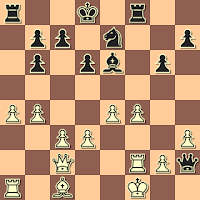The following game reminds me of Douglas Adam's comment, above. I am not exactly sure why.
Wall, Bill - Guest2901729
PlayChess.com, 2015
1.e4 e5 2.Nf3 Nc6 3.Bc4 Nd4
The Blackburne Shilling Gambit.
4.Bxf7+
The Blackburne Shilling Jerome Gambit.
4...Kxf7 5.Nxe5+ Ke7 6.c3 Ne6
It is already possible to see where danger might strike Black: along the d8-h4 diagonal, where his King and Queen are lined up; or in the center, where White's "Jerome pawns" can cause mischief.
7.d4 d6 8.Nd3 Nf6 9.d5
Best according to Stockfish 7.
Interesting was 9.Qe2 as in Philidor 1792 - g-chessman1518, GameKnot.com, 2015(1-0, 22).
9...Nc5 10.Nxc5
dxc5 11.e5
An improvement over the older 11.f3 Ke8 12.O-O Be7 13.c4 Kf7 14.e5 Nd7
15.e6+ Ke8 Black resigned, AMITAF - UofM, FICS, 2010.
11...Nxd5
Trying to escape the inevitable. He should have given up the Knight directly.
12.Bg5+ Nf6 13.exf6+ gxf6
Or 13...Ke8 14.Qxd8+ Kxd8 15.fxg7+ Kd7 16.gxh8=Q Be7 17.Qxh7 Kc6 18.Qxe7 Bd7 19.b4 Re8
20.Qxe8 Bxe8 21.bxc5 Kxc5 22.Nd2 b6 Black resigned, EdoTK - Jorma, FICS, 2006.
14.Bxf6+ Black resigned
Ouch! The Queen is lost.




































